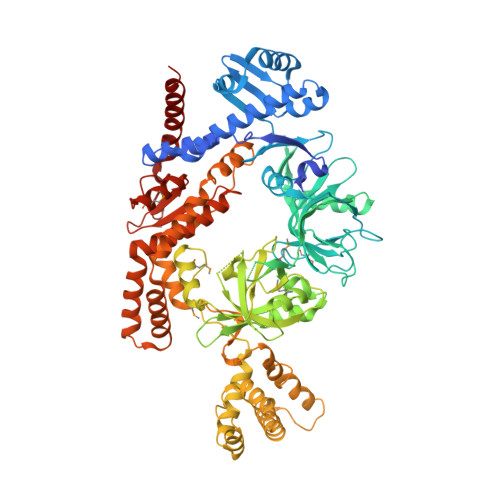Tail-tape-fused virion and non-virion RNA polymerases of a thermophilic virus with an extremely long tail.
Chaban, A., Minakhin, L., Goldobina, E., Bae, B., Hao, Y., Borukhov, S., Putzeys, L., Boon, M., Kabinger, F., Lavigne, R., Makarova, K.S., Koonin, E.V., Nair, S.K., Tagami, S., Severinov, K., Sokolova, M.L.(2024) Nat Commun 15: 317-317
- PubMed: 38182597
- DOI: https://doi.org/10.1038/s41467-023-44630-z
- Primary Citation of Related Structures:
8F5M, 8H2M, 8H2N - PubMed Abstract:
Thermus thermophilus bacteriophage P23-45 encodes a giant 5,002-residue tail tape measure protein (TMP) that defines the length of its extraordinarily long tail. Here, we show that the N-terminal portion of P23-45 TMP is an unusual RNA polymerase (RNAP) homologous to cellular RNAPs. The TMP-fused virion RNAP transcribes pre-early phage genes, including a gene that encodes another, non-virion RNAP, that transcribes early and some middle phage genes. We report the crystal structures of both P23-45 RNAPs. The non-virion RNAP has a crab-claw-like architecture. By contrast, the virion RNAP adopts a unique flat structure without a clamp. Structure and sequence comparisons of the P23-45 RNAPs with other RNAPs suggest that, despite the extensive functional differences, the two P23-45 RNAPs originate from an ancient gene duplication in an ancestral phage. Our findings demonstrate striking adaptability of RNAPs that can be attained within a single virus species.
Organizational Affiliation:
Center of Life Sciences, Skolkovo Institute of Science and Technology, Moscow, 121205, Russia.
















